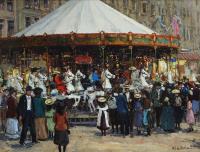
Hennie DeKorte
Born January 5, 1941, the son of a bridge builder, Hennie De Korte spent his early years in Australia after his family moved there in 1952. In 1956 he returned to Holland and studied at the Academy of Fine Arts in Rotterdam. Four years later he was back in Australia and studying at the Art Academy in Sydney. Upon his return to Holland he married, bought a sailing boat, and traveled the world with his new bride. After this trip he applied himself to his chosen profession and had several successful exhibitions in various cities in Europe.
De Korte’s style of impressionism was strongly influenced by the Liebermann Retrospective of 1979. He began his training in Sydney, developing his style from English landscape painting. By studying Gainsborough’s work, De Korte learned the technique of painting with glazes. However, early in his four year study period at the Academy in Rotterdam, De Korte was inspired heavily by Dutch Impressionists such as Maris and deZwart.
In his painting, De Korte searches for what is, for him, characteristic color tones - burnt sienna, umber and Van Dyck brown, and enriches with these colors the pale light conditions of Dutch canal and street scenes. Only his abundant overtones of white accents give his paintings a noteworthy graphic contrast. With choppy brush strokes, De Korte portrays his figures and architecture in color fields, that above all, enrich the viewer’s appreciation of the realistic effects of light. Lively groups of figures of
wonder-filled children at the popular fairs alternate with the busy activity of street merchants. The patter of the horse driven carriages stands wide apart and invites the viewer to contemplate and meditate.
De Korte’s paintings are now sold worldwide in the United States, Europe, Australia and Japan.